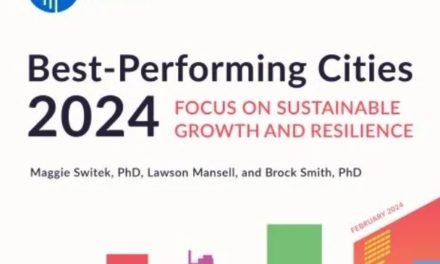Greater Memphis Chamber President Phil Trenary, who’s clearly the right person at the right time for that organization, has said rightfully that the way to reduce poverty in Memphis is to grow the middle class.
As we pointed out seven years, Memphis’s middle class hollowed out. What had begun as white flight transitioned into middle class flight characterized by the out-migration of middle class African Americans. For example, in 1990, 6,675 African Americans lived in DeSoto County, and today, that number has swelled to 40,545, but unfortunately, too many middle class families didn’t stop at the MSA’s borders and thousands moved on to other cities, including a disturbing number of young college graduates.
Because Mr. Trenary is right that we need more middle class families, it is incumbent on us to question our governmental policies and programs. It is also incumbent on us to question economic development policies and programs, because in the past 20 years, no city and county have waived more city-county taxes – roughly $1.5 billion in tax breaks to big business – and not only did our middle class shrink, our poverty rate climbed.
Chief among mantras heard often here is that we can reduce poverty by creating more jobs, and this is regularly used to justify jobs that pay $9 or $10 an hour. Here’s the thing: 50% of adults in Memphis living in poverty are in fact working, which tells us that just like we finally realized the mistake in thinking that that every road is a good road, we now need to question the notion that any job is a good job.
The Harsh Realities for Single Mothers
More to the point, these low-paying jobs do little to create a middle class. After all, the living wage for a family with one adult and one child is $18.18. So, even if someone takes a $10 an hour job, that person remains in a financial hole with little hope of climbing out.
The United States already leads other high-income countries in its percentage of single mothers. Research shows that single mothers are employed for longer hours and yet U.S. single mothers have much higher poverty rates than their peers in other high-income countries. As for Shelby County, it is a national leader in female-headed households, and 43% of them are earning poverty incomes.
While it sounds more upbeat for a women with small children to say she works at a distribution center rather than as a domestic worker, the distance between the two remains short. It is generally the case that neither pays a living wage and the worker still must rely on taxpayer-funded health care programs like Regional One Health (formerly The Med), its Health Loop clinics, and the Memphis and Shelby County Health Department.
And yet, the same hard facts of life apply to men working in distribution jobs whose companies continue to receive generous taxpayer subsidies with PILOTs and that manipulate the system with temporary workers to sidestep assurances to EDGE that they are offering jobs with health insurance. These are people who are playing by the rules, working hard for paychecks, and yet, many of them rely on public services.
Distribution, Really?
It’s hard not to draw a straight line between our languishing economy and our overdependence on distribution and logistics jobs. At the time of the Memphis Jobs Conference, where “America’s Distribution Center” was born, there were warnings by economists that keying on distribution was not the best economic policy because of the low wages paid by the industry and the incentive for a low-wage workforce.
Thirty years later, it’s inarguable that their predictions have come to pass. And in the past 15 years, the negative economic indicators stepped up their paces as our region lost tens of thousands of jobs, the poverty rate increased, the median household income went down, public tax revenues flatlined, and our Next Economy preparedness slumped.
Yes, our region suffered mightily from the Great Recession, but the truth is that the negative indicators for the Memphis MSA had begun years earlier. Put simply, more PILOTs have not reduced poverty or increased incomes at a rate in line with our peer cities.
Perhaps, more than anything, it’s time to prove that we are not mere rubber stamps for any PILOT request by dialing back our largesse when it comes to distribution. Besides the problems associated with the overemphasis on this sector and its low wages, there are also the manipulations within the industry that raise questions about the wisdom of investing incentives in it.
Working Around Fairness
For example, PILOT evaluation eligibility speaks to the need for “minimum medical benefits where the employer pays at least 50% of the cost of the medical insurance premium for those jobs considered as a PILOT project job in determining PILOT eligibility and compliance.” Through the cynical use of temporary workers, distribution companies here dodge this criterion.
Areas with high concentrations of temp workers have been identified as Grand Rapids, MI; Middlesex County, NJ; Lehigh County, PA; and Shelby County (where 5.8% are temporary workers – the fifth highest rate for counties with more than 100,000 in population). It’s been said that in temp towns, it’s not unusual to find warehouses with virtually no employees of their own, and workers tell stories of working for years as a temp. The use of temporary workers means that the companies are inoculated against workers’ compensation claims, unemployment taxes, union drives, and the responsibility to ensure that workers are legal immigrants…and EDGE requirements for insured workers.
All in all, it exacerbates inequality in this community, where low-wage occupations have dominated the recovery with 58 percent of job gains since 2010. It’s no wonder that median household incomes in our community peaked in 1999 and today the median household income in Memphis is less than a living wage for one adult and one child.
All in all, the trends make the dream of upward mobility more and more a delusion, particularly for a city where almost 50 percent of its children living in poverty. A child born into the bottom 20 percent of the income distribution (in Memphis the bottom 20 percent has a household income of $13,522, or 88 cents less than the minimum wage salary) has a less than 1-in-20 chance of making it to the top 20 percent. To make matters worse, between 2007-2012, the bottom 20th percentile saw a salary decrease of $1,231 in Memphis.
Low Wages Mean Low Progress
These are the realities that complicate our hopes of fighting inequality – and creating more middle class families – in Memphis, particularly when a seminal selling point for our city to prospective businesses is our cheap labor. It’s why we cringe when we see headlines like the one in The Commercial Appeal: “Low wages help attract manufacturers to Memphis.”
The ramifications of these modest paychecks ripple throughout the Memphis economy. There’s less money for the consumer spending that produces important revenues to pay for vital city services, there’s less money for the kind of enriched opportunities that are keys to children’s social and emotional development, there’s less money for the extras that make life more enjoyable for families, but most of all, there’s less money to pay for food, child care, medical expenses, housing, and transportation.
More than anything, there are fewer middle class families, and the barriers to creating them grow higher with each distribution PILOT.





There is one huge reason middle class Memphians move to the suburbs: schools. I would bet the farm that if the 40K or so black Memphians who moved to Desoto County in the past two decades were polled of their reasons for moving, schools would be at the very top. It would probably not even be close. The sad truth is that no person with a choice would send their children to the schools within the city limits. And it is not simply for typical reasons like test scores. It is also for safety of their children and the environment. That can not be discounted.
I always appreciate the fact the SCM “localizes” our situation in terms that relate to the national scene. While many of the issues of Memphis are particular to our city, overall this is a problem the whole nation faces and is suffering from.
The middle class is diminishing everywhere as the benefits of the so-called recovery are going almost exclusively to the wealthiest.
I guess I’ll believe that the chamber and the business community care about the middle class here and elsewhere when they start calling for and implementing a rise in wages in the community. Or you see a call for some kind of linkage whereby those receiving PILOT breaks have to provide a higher wage level than minimum. There has to be some kind of literal “payback” for all these giveaways. Some communities around the country are already doing this
The city and country in general are becoming service-based and until the companies that are receiving the increased productivity and labor of their workers share that in the form of higher wages this will continue to plague Memphis and the country in general.
@Memphisj
This is a major issue as businesses/restaurants that cater to the middle class (e.g.. Applebees, Red Lobster, Olive Garden types) are struggling, while businesses that cater to either the very poor (i.e., Family Dollar) or the very rich (i.e., Four Seasons, Capital Grille) are doing well.
The following link is an excellent argument by Nick Hanauer for increasing the minimum wage to $15: “The Capitalist’s Case for a $15 Minimum Wage”
http://www.bloombergview.com/articles/2013-06-19/the-capitalist-s-case-for-a-15-minimum-wage
To put this in perspective, medical costs in this country work out to about $12 per hour across the hours worked per year. So this means that anyone not making a career average earning above $12 per hour can’t even cover medical costs throughout their life.
Calls for increased minimum wage attracts calls of “socialist” from the right, but in response we must ask why do they want to “socialize” the labor costs of large businesses by making the rest of us pick up the tab?
A $15/hour minimum wage would practically break the back of the poverty industry in Memphis.
along with 50% of the locally franchised fast food joints, when their patrons refuse to pay 8 bucks for a single with cheese.
when they collectively perform a job WORTH $15 an hour-holla back.
and mcdonalds isn’t meant to support a family of 4 or 7 or whatever the current average count is.
@ Anonymous
– If the minimum wage had tracked U.S. productivity gains since 1968, it would be ~ $21/hour
– Has there ever been a recession or economic downturn caused by a minimum wage increase?
– Why are cities such as San Francisco, Portland and Seattle are doing well in spite of having higher minimum wage requirements than the federal mandate?
– Don’t you think that workers earning more will be able to spend more, which will in turn increase demand and grow businesses?
– More income makes lower income workers less dependent on gov’t programs. Why should the taxpayers subsidize the labor of large corporations (i.e., PILOT programs)?